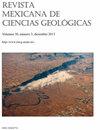墨西哥东南部恰帕斯州Tuxtla gutisamurez西北序列马斯特里赫特有孔虫组合的生物地层学和古环境
IF 0.5
4区 地球科学
Q4 GEOSCIENCES, MULTIDISCIPLINARY
Revista Mexicana De Ciencias Geologicas
Pub Date : 2021-03-24
DOI:10.22201/CGEO.20072902E.2021.1.1598
引用次数: 0
摘要
在马斯特里赫特时期,恰帕斯中部地区沉积了两个岩石地层单元;Ocozocoautla和Angostura组。第一个单位在恰帕斯中部的图克斯特拉古蒂萨雷兹市西北部种植。它是一个复杂的岩性单元,主要由硅屑岩与灰岩互层组成。在它上面,安格斯图拉石灰岩被识别出来。本研究的重点是对两个地层中较大的底栖和浮游有孔虫进行分类研究,以确定年龄和推断古环境。Ocozocoautla组包括底栖动物和重要的浮游有孔虫。根据微化石地层分布,划分了两个生物带:最早马斯特里克特时期的Pseudorbitoides rutteni - ayalaina rutteni组合带和早期马斯特里克特时期的Gansserina gansseri区间带上部。Angostura组含有水藻和较大的有孔虫,它们被认为是浅水环境中重要的年龄标志。确定了两个有孔虫区间带,即马氏晚期早期Praechubbina breviclaustra区间带和马氏晚期至晚期Chubbina jamaicensis总范围带。微相(粒岩、尾岩-包岩、尾岩)和有孔虫组合重建了古环境,表明该矿床发育于中-高能的开阔海相环境,在Ocozocoautla组以底栖和浮游有孔虫为特征,而在Angostura组则为浅水海洋保护环境。Ocozocoautla和Angostura组组合的古生物地理分布主要包含加勒比海省特有的底栖有孔虫和Angostura组的其他少数Tethysian形式。本文章由计算机程序翻译,如有差异,请以英文原文为准。
Biostratigraphy and paleoenvironment of Maastrichtian foraminiferal assemblages from a succession located NW of Tuxtla Gutiérrez, Chiapas (SE Mexico)
During the Maastrichtian, two lithostratigraphic units were deposited in the central Chiapas region; the Ocozocoautla and Angostura formations. The first unit crops out northwest of the city of Tuxtla Gutiérrez in central Chiapas. It is a complex lithological unit mainly composed of siliciclastic rocks interbedded with limestone. Overlying it, the Angostura limestone is recognized. This study focuses on a taxonomic study of the larger benthic and planktic foraminifera from both formations in order to assign age and to infer the paleoenviroment. The Ocozocoautla Formation includes an association of benthic as well as significant planktic foraminifera. Based on the microfossils stratigraphic distribution, two biozones were defined: the Pseudorbitoides rutteni–Ayalaina rutteni Assemblage Zone of earliest Maastrichtian and the upper part of the Gansserina gansseri Interval Zone of early Maastrichtian. The Angostura Formation contains dasycladacean algae and larger foraminifera considered as important age markers in shallowwater environments. Two foraminiferal interval zones were defined, Praechubbina breviclaustra Interval Zone of early late Maastrichtian and Chubbina jamaicensis Total Range Zone of late to latest Maastrichian age. The microfacies (grainstone, wackestone–packstone, wackestone) as well as the foraminiferal assemblage enable the paleoenvironment to be reconstructed, suggesting a deposit that developed in an openwater marine setting with moderate to high energy, characterized by benthic and planktic foraminifera in the Ocozocoautla Formation, while in the Angostura Formation a shallow-water marine protected environment is inferred. The paleobiogeographical distribution of the assemblage from both the Ocozocoautla and Angostura formations mostly contains endemic benthic foraminifera of the Caribbean Province and other few Tethysian forms of the Angostura Formation.
求助全文
通过发布文献求助,成功后即可免费获取论文全文。
去求助
来源期刊

Revista Mexicana De Ciencias Geologicas
地学-地球科学综合
CiteScore
1.00
自引率
12.50%
发文量
0
审稿时长
6-12 weeks
期刊介绍:
Revista Mexicana de Ciencias Geológicas (RMCG) publishes original research papers on geological processes of broad interest, and particularly those dealing with regions of Latin America. The RMCG also publishes review papers on topics of current interest, and on the geology and tectonics of geological provinces of Latin America. Besides, it offers the opportunity for host editors to publish special thematic issues.
 求助内容:
求助内容: 应助结果提醒方式:
应助结果提醒方式:


